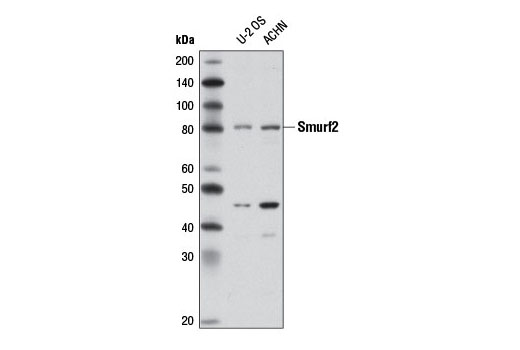WB, IP
H M R Mk
Endogenous
80
Rabbit IgG
#Q9HAU4
64750
Product Information
Product Usage Information
| Application | Dilution |
|---|---|
| Western Blotting | 1:1000 |
| Immunoprecipitation | 1:50 |
Storage
Specificity / Sensitivity
Species Reactivity:
Human, Mouse, Rat, Monkey
Source / Purification
Monoclonal antibody is produced by immunizing animals with a synthetic peptide corresponding to residues surrounding Pro160 of human Smurf2 protein.
Background
Smad ubiquitin regulatory factor 2 (Smurf2) is a HECT domain E3 ubiquitin ligase. It was initially identified as an inhibitor of TGF-β/BMP signaling by targeting R-Smads and TGF type I receptor for ubiquitination and degradation (1-3). Subsequent studies have revealed its role in neuronal and planar cell polarity, as well as in the senescence response and suppression of tumorigenesis (4-8). Smurf2 has a broad range of substrates including RUNX2, AMSH, Rap1B, and RNF11 (5,9-11). Smurf2 is widely expressed in various tissues. The C2 domain of Smurf2 inhibits its catalytic activity by interacting with the HECT domain (12). Research studies have shown that Smurf2 functions as a tumor suppressor by maintaining genomic stability through targeting RNF20 (13).
- Zhang, Y. et al. (2001) Proc Natl Acad Sci U S A 98, 974-9.
- Kavsak, P. et al. (2000) Mol Cell 6, 1365-75.
- Izzi, L. and Attisano, L. (2004) Oncogene 23, 2071-8.
- Zhang, H. and Cohen, S.N. (2004) Genes Dev 18, 3028-40.
- Schwamborn, J.C. et al. (2007) EMBO J 26, 1410-22.
- Narimatsu, M. et al. (2009) Cell 137, 295-307.
- Nie, J. et al. (2010) J Biol Chem 285, 22818-30.
- Ramkumar, C. et al. (2012) Cancer Res 72, 2714-9.
- Subramaniam, V. et al. (2003) Br J Cancer 89, 1538-44.
- Li, H. and Seth, A. (2004) Oncogene 23, 1801-8.
- Kaneki, H. et al. (2006) J Biol Chem 281, 4326-33.
- Wiesner, S. et al. (2007) Cell 130, 651-62.
- Blank, M. et al. (2012) Nat Med 18, 227-34.
Species Reactivity
Species reactivity is determined by testing in at least one approved application (e.g., western blot).
Western Blot Buffer
IMPORTANT: For western blots, incubate membrane with diluted primary antibody in 5% w/v nonfat dry milk, 1X TBS, 0.1% Tween® 20 at 4°C with gentle shaking, overnight.
Applications Key
WB: Western Blotting IP: Immunoprecipitation
Cross-Reactivity Key
H: human M: mouse R: rat Hm: hamster Mk: monkey Vir: virus Mi: mink C: chicken Dm: D. melanogaster X: Xenopus Z: zebrafish B: bovine Dg: dog Pg: pig Sc: S. cerevisiae Ce: C. elegans Hr: horse GP: Guinea Pig Rab: rabbit All: all species expected
Trademarks and Patents
Limited Uses
Except as otherwise expressly agreed in a writing signed by a legally authorized representative of CST, the following terms apply to Products provided by CST, its affiliates or its distributors. Any Customer's terms and conditions that are in addition to, or different from, those contained herein, unless separately accepted in writing by a legally authorized representative of CST, are rejected and are of no force or effect.
Products are labeled with For Research Use Only or a similar labeling statement and have not been approved, cleared, or licensed by the FDA or other regulatory foreign or domestic entity, for any purpose. Customer shall not use any Product for any diagnostic or therapeutic purpose, or otherwise in any manner that conflicts with its labeling statement. Products sold or licensed by CST are provided for Customer as the end-user and solely for research and development uses. Any use of Product for diagnostic, prophylactic or therapeutic purposes, or any purchase of Product for resale (alone or as a component) or other commercial purpose, requires a separate license from CST. Customer shall (a) not sell, license, loan, donate or otherwise transfer or make available any Product to any third party, whether alone or in combination with other materials, or use the Products to manufacture any commercial products, (b) not copy, modify, reverse engineer, decompile, disassemble or otherwise attempt to discover the underlying structure or technology of the Products, or use the Products for the purpose of developing any products or services that would compete with CST products or services, (c) not alter or remove from the Products any trademarks, trade names, logos, patent or copyright notices or markings, (d) use the Products solely in accordance with CST Product Terms of Sale and any applicable documentation, and (e) comply with any license, terms of service or similar agreement with respect to any third party products or services used by Customer in connection with the Products.

